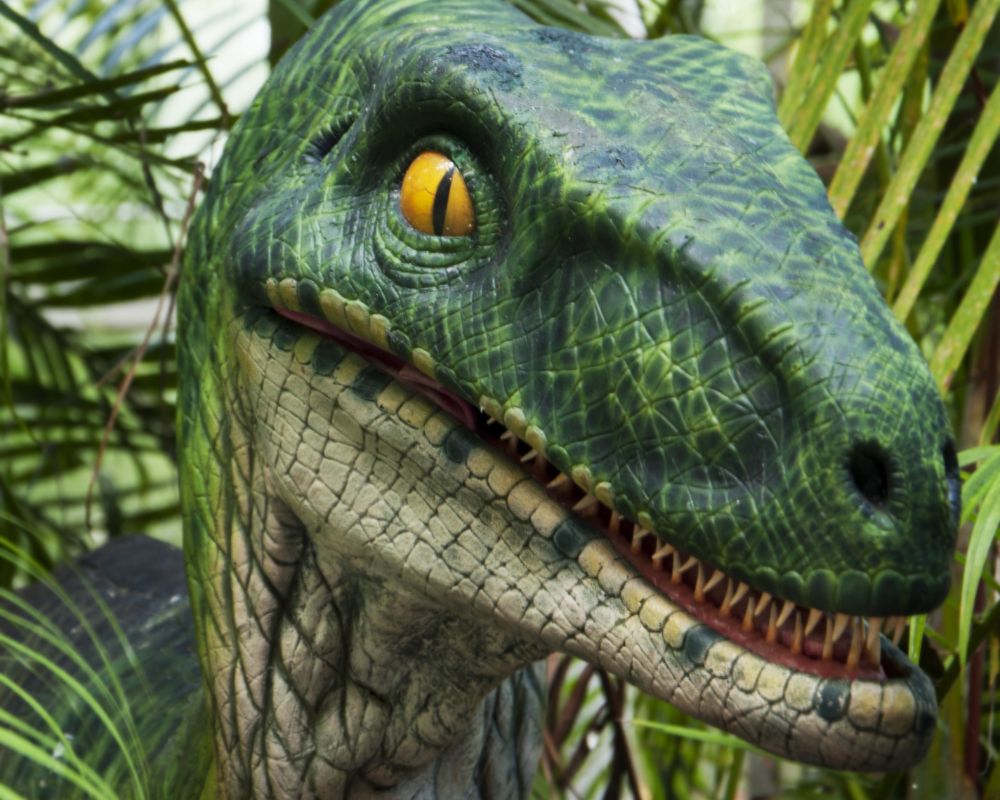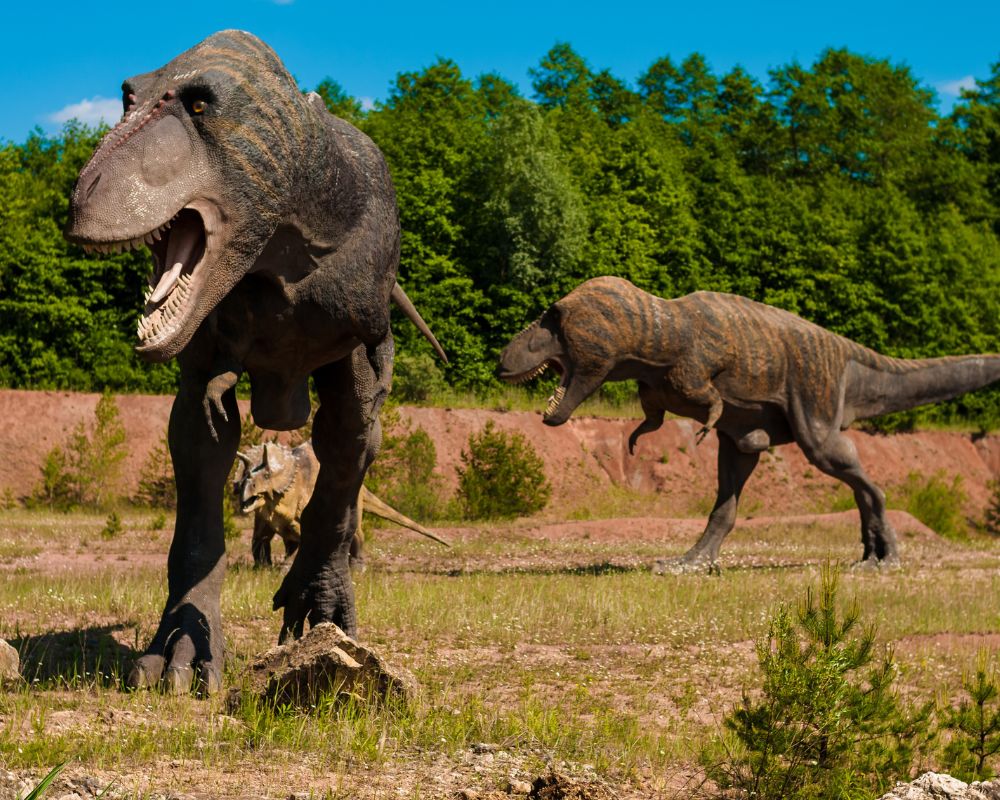The Allosaurus would win over the Ceratosaurus every time based on size comparison alone. The Allosaurus was bigger, heavier, and had longer forearms. But the Ceratosaurus had a horn and a crocodile-like tail made for swimming. Like many battles between two carnivorous dinosaurs, the battle of Allosaurus vs. Ceratosaurus wasn’t always in the Allosaur’s favor.
Table of Contents
Battle Facts about Allosaurus vs. Ceratosaurus

| Name | Allosaurus (Allosaurus fragilis) | Ceratosaurus (Ceratosaurus nasicornis) |
| Size | 28 feet long,13-16 feet tall | 22-23 feet long, 5.5-6.5 feet tall |
| Speed | 21 mph | 20-30 mph |
| Offense | Size and sharp teeth | Strong bite |
| Defense | Grasping claws, longer forearms, thick back legs | Horn, speed, swimming |
| Endurance and Behavior | Cooperative hunters | Could swim |
An Allosaurus and a Ceratosaurus were carnivorous dinosaurs from the Late Jurassic period. They lived in the same area, and both preyed on Sauropods. These two Theropod dinos sometimes fought over food, and the bigger, stronger Allo would almost always win. But the Ceratosaurus had a few creatures features that made for an interesting dinosaur battle royale!
Were the Allosaurus and the Ceratosaurus Related?

The Allosaurus and the Ceratosaurus were not closely related. The Allosaurus was from the Allosauridae family. The Ceratosaurus was from the Abelisauridae family.
The Allosaurus and the Ceratosaurus were both Theropod dinosaurs. Theropod dinos walked on two legs and had hollow bones. There are hundreds of Theropod dinosaur species, including:
- The Carnotaurus
- The Spinosaurus
- The Suchomimus
- The Tarbosaurus
- The T-rex
- The Velociraptor
Spinosaurus (Spino) was the largest known Theropod, even bigger than T-rex!
What was the difference between the Allosaurus and the Ceratosaurus?
The Allosaurus and the Ceratosaurus looked very similar but were two entirely different types of Theropod dinos. The Allosaurus was bigger and heavier. The Ceratosaurus had a horn and a thicker, alligator-like tail it used for swimming.
Allosaur was a land-only Allosaur, related to other Theropod giants like Carcharodontosaurus and Giganotosaurus. Saurophaganax was another relative of Allo, but recent studies suggest that Saurophaganax might be a synonym of the Allosaurus. The Allosaurus preferred to stay away from waterways and stick to the interior dry land.
The Ceratosaurus lived near the water with another Theropod called the Torvosaurus. The Ceratosaurus’s tail was powerful, and paleontologists believe they were good swimmers. The Ceratosaurus was not a marine reptile like the Mosasaurus; it could get into the water and swim when needed.
What did the Allosaurus and the Ceratosaurus have in Common?

Allosaurus and Ceratosaurus dinos lived in North America during the Late Jurassic Period. Their fossils have been found in other places, such as Portugal, but the European and North American continents were much closer 150 million years ago. They were both carnivorous dinosaurs that hunted and scavenged other dinos.
Allosaurus and Ceratosaurus were found in the area that is now Colorado, Utah, Montana, and Wyoming. Paleontologists have found fossils of several different species of dinos in this area that lived around the same time! These dinos include:
- The Apatosaurus
- The Brachiosaurus
- The Comptosaurus
- The Diplodocus
- The Stegosaurus
Well-known Cretaceous Period dinos were also found in this area of North America. North America was full of dinos like:
- The Albertosaurus
- The Ankylosaurus
- The Styracosaurus
- The Triceratops
- raptors like the Deinonychus and the Utahraptor
- The Tyrannosaurus rex
Was the Allosaurus stronger than the Ceratosaurus?
The Allosaurus was about twice as tall and heavy as the Ceratosaurus. Because of this, the Allosaurus was naturally stronger. But being the bigger dino was not always better.
Adult Allosaurus fossils show lots of fractures due to the dinosaur’s size. Healing fractures and infections were found to be the cause of death for the largest Allosaurus fossil. This fossil is known as “Big Al.”
Allosaurs with healing fractures were weaker than other dinos, which could help the Ceratosaurus in battle. The Ceratosaurus has been known to eat fallen Allosauruses. Like all carnivorous dinosaurs, Ceratosauruses would take advantage of a weakened Allosaurus.
Who was faster, the Allosaurus or the Ceratosaurus?
The Ceratosaurus could run as fast as 30 mph for short distances. The Allosaurus had an average speed of about 21 mph. The Ceratosaurus was faster, but short bursts of speed were not always enough to get away from a long-distance runner like the Allosaurus.
Some paleontologists have estimated that the Allosaurus could run up to 34 mph! Most scientists agree that the Allosaurus was closer to 19-21 mph. But more discoveries are always being made, and Allosaurus could have been faster than the Ceratosaurus.
Who would win in a fight?
The Allosaurus would most likely win a fight with the Ceratosaurus. Bigger, stronger, and heavier Allosaurus had a lot of advantages. If some estimates are correct, the Allosaurus might have been faster than Ceratosaurus.
Still, the Ceratosaurus could win against the Allosaurus in certain situations. If the Ceratosaurus could get to the water and swim away, the Allosaurus couldn’t catch it. The Ceratosaurus also had better hearing than Allosaurus, which meant the Ceratosaurus could ambush the Allosaurus or simply avoid it altogether.
The Ceratosaurus could also knock the Allosaurus over like the Triceratops did vs. T-rex. The Ceratosaurus had horns and a thick tail. Once the Allosaurus was on the ground, the Ceratosaurus could attack or run away.
On land, the Allosaurus had a clear advantage. But the Ceratosaurus could swim and stay near the deep waterways that went through the ancient North American continent. Luckily for the Ceratosaurus, the Allosaurus didn’t like the same environment and mostly stayed away from waterways!
